
For this edition of Classic Steel, we are going to take a look back at Suzuki’s all-new 1993 RM125.
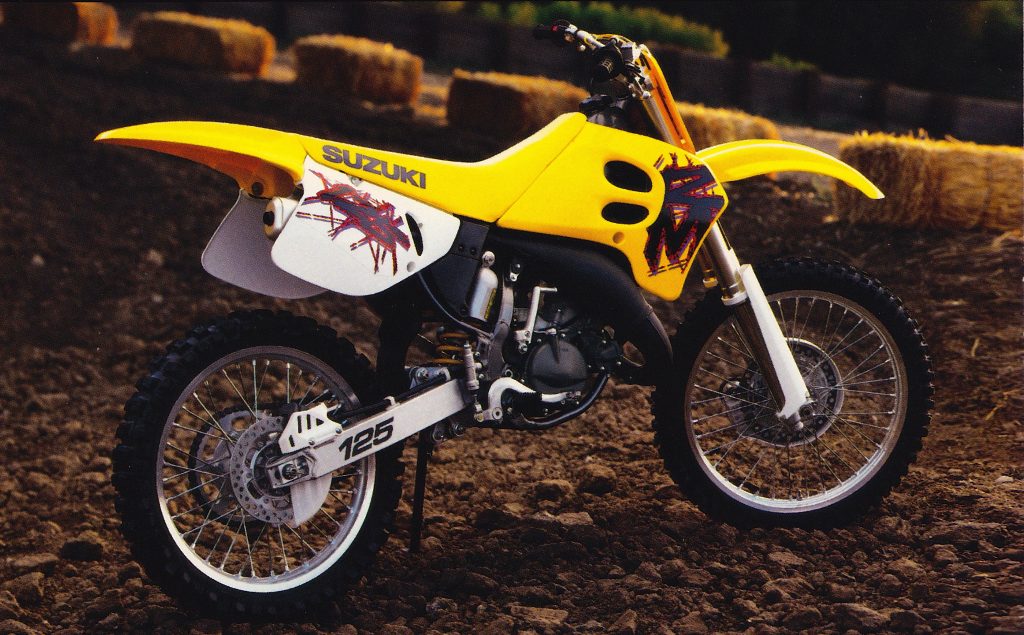 All-new for 1993, Suzuki’s RM125 offered bold new styling that was a radical departure from the previous two seasons. Photo Credit: Suzuki
All-new for 1993, Suzuki’s RM125 offered bold new styling that was a radical departure from the previous two seasons. Photo Credit: Suzuki
The early 1990s were a great time to be riding a Suzuki in the 125 class. After falling far behind their competition in the mid-to-late eighties, Suzuki came roaring back in the early nineties with a succession of ultra-competitive yellow 125s. During this era, the RMs carved out a successful niche with their snappy powerbands and razor-sharp handling. While they were not as outright fast as the Hondas of the era, their more accessible power characteristics, well-sorted suspension, and feather-light feel made them extremely popular with riders looking for an alternative to the fast but demanding to ride CRs.
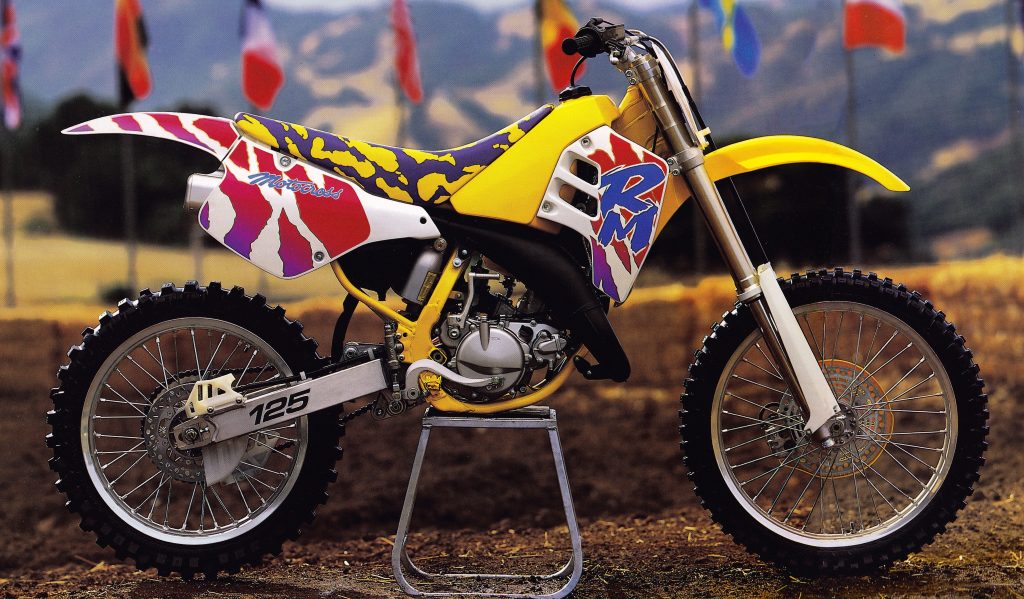 Love it or hate it, there was no denying that the 1992 Suzuki RM125 was a bold styling statement. Underneath all of those comical graphics beat the heart of a winner. Photo Credit: Suzuki
Love it or hate it, there was no denying that the 1992 Suzuki RM125 was a bold styling statement. Underneath all of those comical graphics beat the heart of a winner. Photo Credit: Suzuki
In 1992, this combination of right-now power, good-enough suspension, and lithe handling had been enough to push the controversially styled RM125 to the front of a very competitive field. The CR was faster and the KX was plusher, but no other bike covered all of its bases like the do-it-all RM. For most riders, the biggest knock on the 1992 RM125 was its outlandish styling, which pushed the boundaries of good taste in an era where gold lame Hammer pants and neon fanny packs were considered de rigueur.
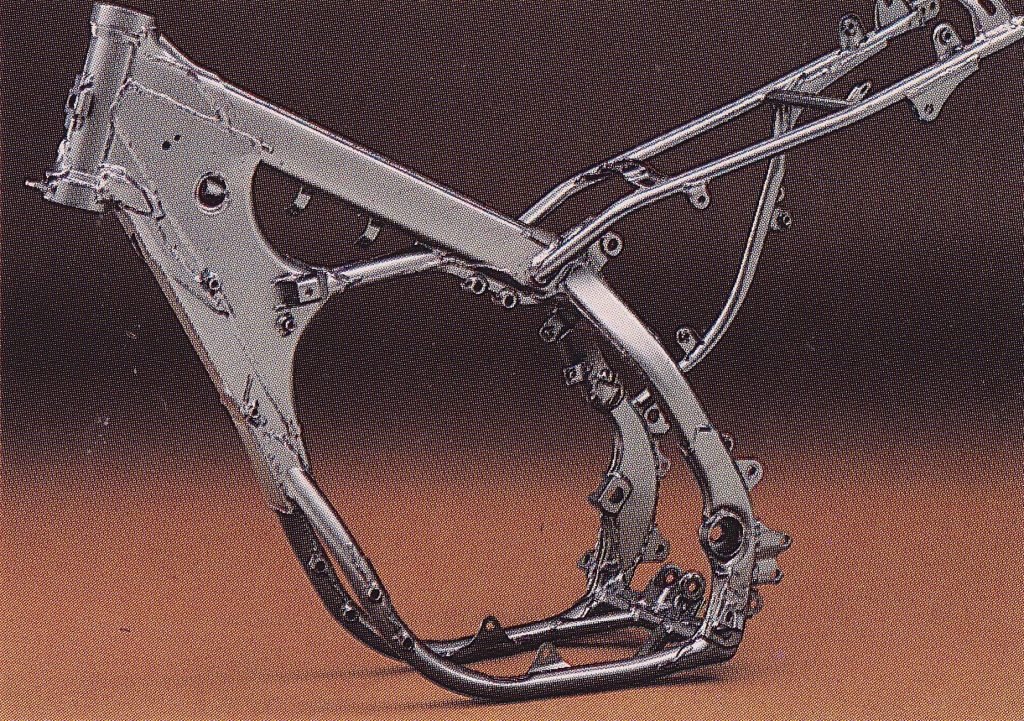 After a complete redesign of the RM125’s chassis in 1992, Suzuki chose to focus on strength for 1993. The new frame maintained most of the 1992’s dimensions but added a beefed-up backbone that Suzuki claimed reduced flex by 30 percent. Photo Credit: Suzuki
After a complete redesign of the RM125’s chassis in 1992, Suzuki chose to focus on strength for 1993. The new frame maintained most of the 1992’s dimensions but added a beefed-up backbone that Suzuki claimed reduced flex by 30 percent. Photo Credit: Suzuki
For 1993, Suzuki looked to build on their 125 class success by refining, reshaping, and restyling their RM125. In 1992, the RM125 had received an all-new frame which had upped chassis rigidity by 25 percent and endowed the yellow (and white, and purple, and pink) 125 with the sharpest turning on the track. For 1993, Suzuki once again upped the chassis rigidity by beefing up the box-section backbone of the frame. Overall geometry was unchanged, but Suzuki claimed another 30 percent increase in chassis strength over 1992.
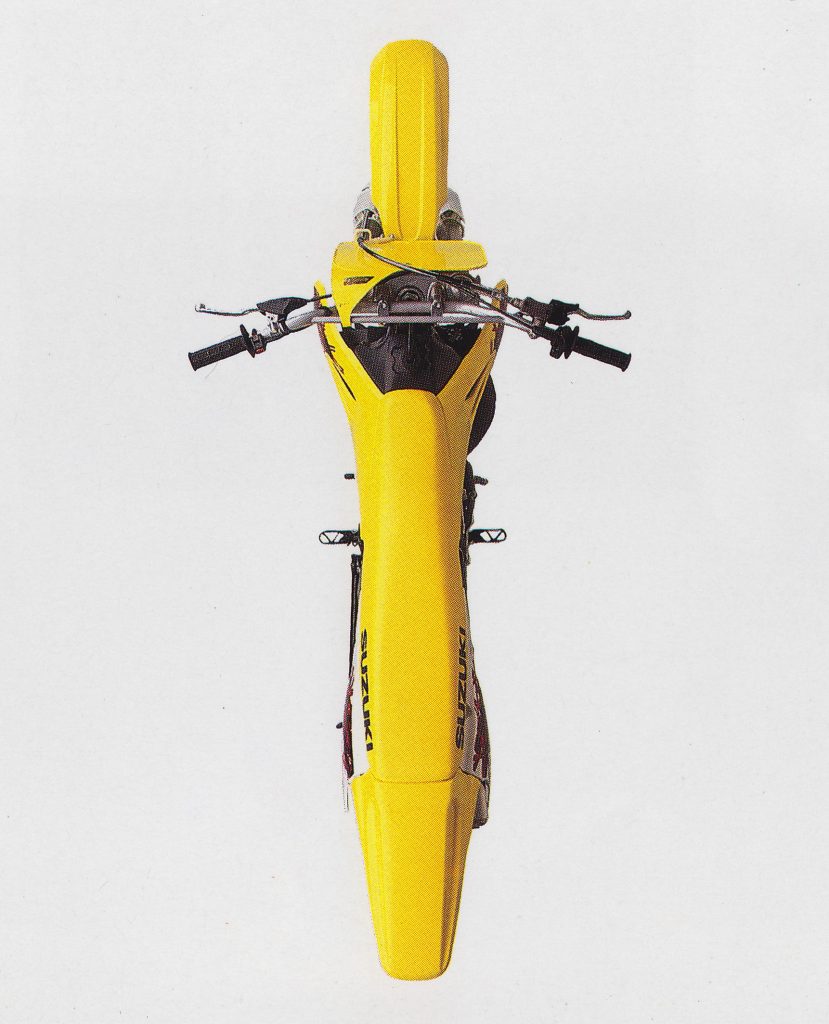 All-new bodywork smoothed out the rider compartment and actually increased width through the middle for 1993. By making the bike wider at the knees Suzuki felt they could increase rider control and comfort. Photo Credit: Suzuki
All-new bodywork smoothed out the rider compartment and actually increased width through the middle for 1993. By making the bike wider at the knees Suzuki felt they could increase rider control and comfort. Photo Credit: Suzuki
Matched to the new frame was a redesigned set of 45mm Showa front forks that featured slightly thinner tubing for ’93 to save weight and fine-tune the chassis feel. In the rear, the Showa shock featured an all-new compression damping system with a 5mm larger piston to flow more fluid. The fluid was also upgraded for 1993 with a redesigned formulation Suzuki claimed would be more resistant to heat and less prone to fading. Paired with the new shock was a revised linkage and swingarm which employed the same progressive curve as 1992 but offered increased strength for reduced flex.
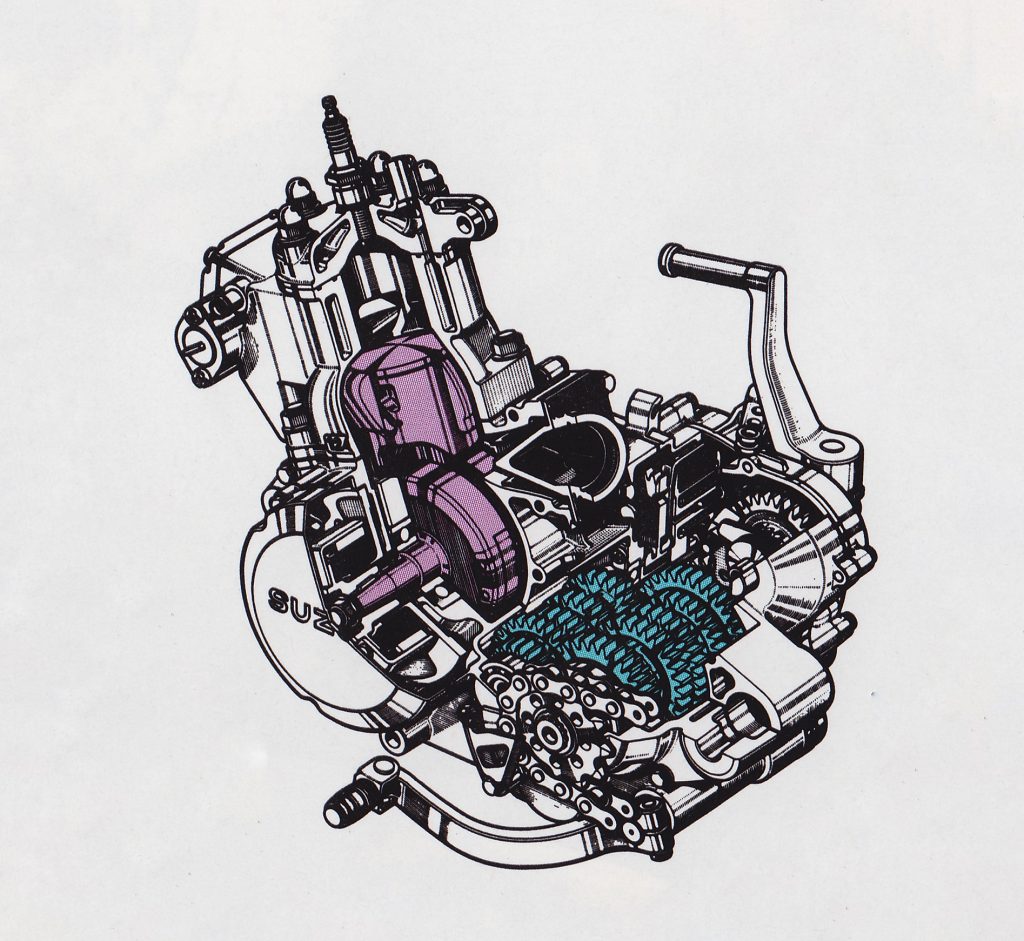 Motor changes for 1993 included an all-new cylinder, revised AETC, rebalanced crank, larger carburetor, and revised exhaust. Photo Credit: Suzuki
Motor changes for 1993 included an all-new cylinder, revised AETC, rebalanced crank, larger carburetor, and revised exhaust. Photo Credit: Suzuki
On the motor front, the 1993 RM125 employed a highly modified version of the 1992 RM’s 124cc case-reed mill. In use since 1989, this basic design was renowned for its strong low-end and midrange power. Top-end thrust was sorely lacking in this generation of RM mills, but the motors were snappy, fun, and far easier to ride than pro-focused powerbands found on the Hondas of the time. For 1993, Suzuki looked to increase the RM’s midrange and broaden its overall power by adding several updates to the popular motor. An all-new cylinder added exhaust boost ports and enlarged the scavenging ports for better flow. The AETC power valve system was also revised to allow the valve to slide 1mm farther down into the exhaust port. A new crank plugged the balancing holes of 1992 and increased the primary compression. In order to improve lubrication, the oil holes drilled into the piston were reduced in number but increased in size. Suzuki claimed this also made the piston lighter for 1993. Feeding fuel and air to the motor was an all-new 36mm Mikuni carburetor and redesigned airbox. Both were enlarged for 1993 with the carburetor growing 1mm in size over 1992. The new airbox featured what Suzuki called an “open air” design that they claimed would triple the time between filter services and offer a 20 percent increase in airflow to the motor. Keeping things cool was an all-new set of radiators that Suzuki claimed was more efficient for 1993. The transmission remained a six-speed and continued to offer one of the smoothest-shifting mechanisms in the class. Finishing off the motor package was an all-new exhaust system that Suzuki designed to pull farther on top for 1993.
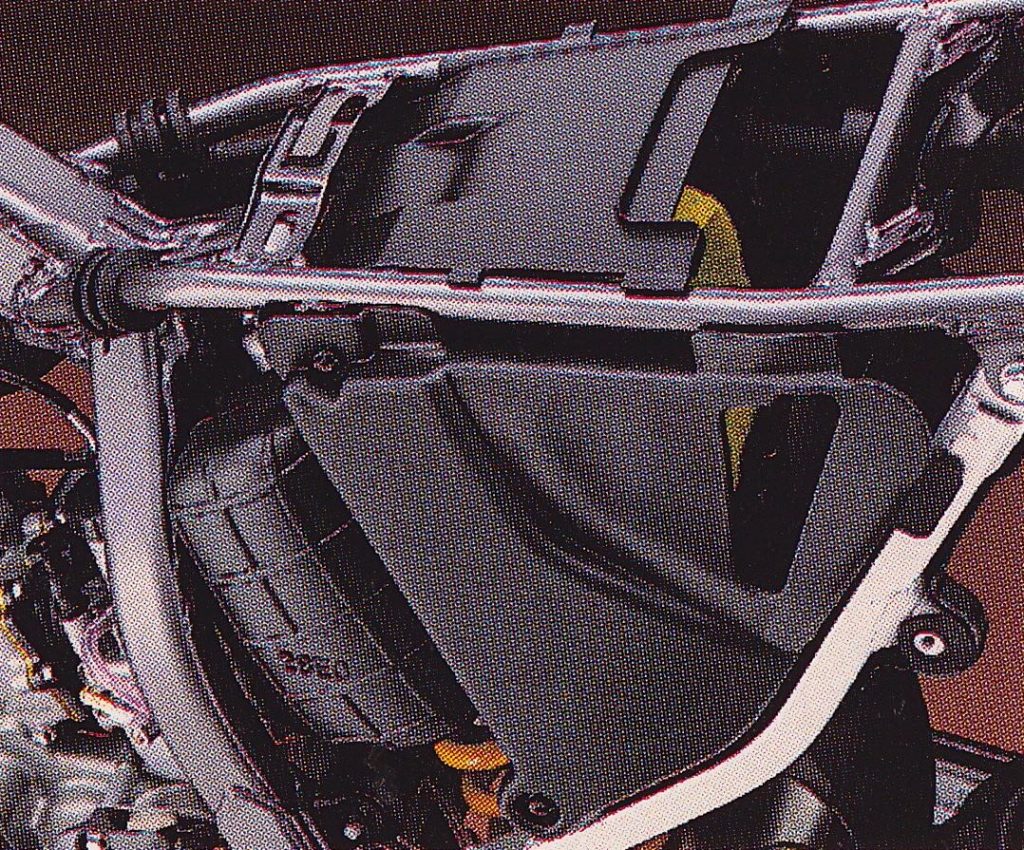 An all-new airbox for 1993 offered 20 percent more airflow and a set of bolt-on outer covers that added to the bike’s beefy midsection. Photo Credit: Suzuki
An all-new airbox for 1993 offered 20 percent more airflow and a set of bolt-on outer covers that added to the bike’s beefy midsection. Photo Credit: Suzuki
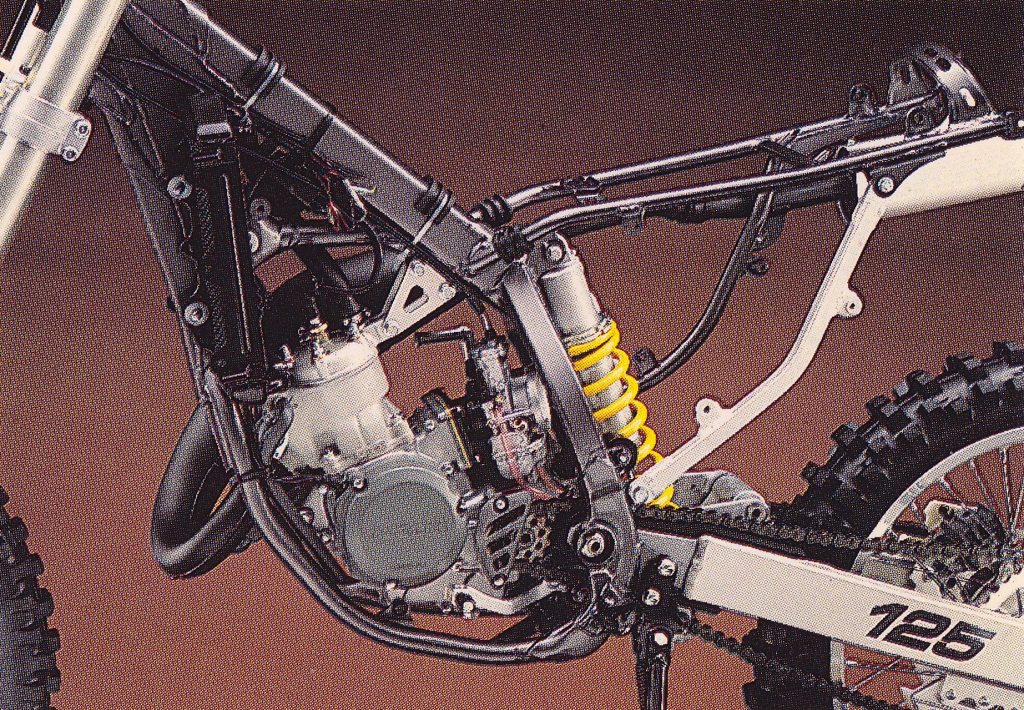 An all-new shock for 1993 employed a redesigned compression damping system and a revised fluid for slicker performance and reduced fading. Photo Credit: Suzuki
An all-new shock for 1993 employed a redesigned compression damping system and a revised fluid for slicker performance and reduced fading. Photo Credit: Suzuki
While much of the basic DNA of the RM125 remained similar to 1992, its outward appearance certainly did not. All-new bodywork and graphics moved away from the extreme colors of 1992 towards a much more restrained all-yellow design. The new frame was painted an understated carbon gray and all the motor castings featured a trick gunmetal coating that gave them a works-style sand-cast appearance. The redesigned bodywork incorporated Kawasaki-style “wrap around” radiator shrouds and a longer and flatter seat that made sliding forward in the turns easier for ’93. One interesting choice Suzuki made for 1993 was to increase the width of the RM125. Apparently, testers found that making the bodywork thicker through the middle aided in gripping the machine, so Suzuki spaced out the airbox and added thickness to the shrouds to give riders more to hold on to. While this change was met with a bit of skepticism at the time, most riders actually ended up liking the feel of the new thicker ergonomics.
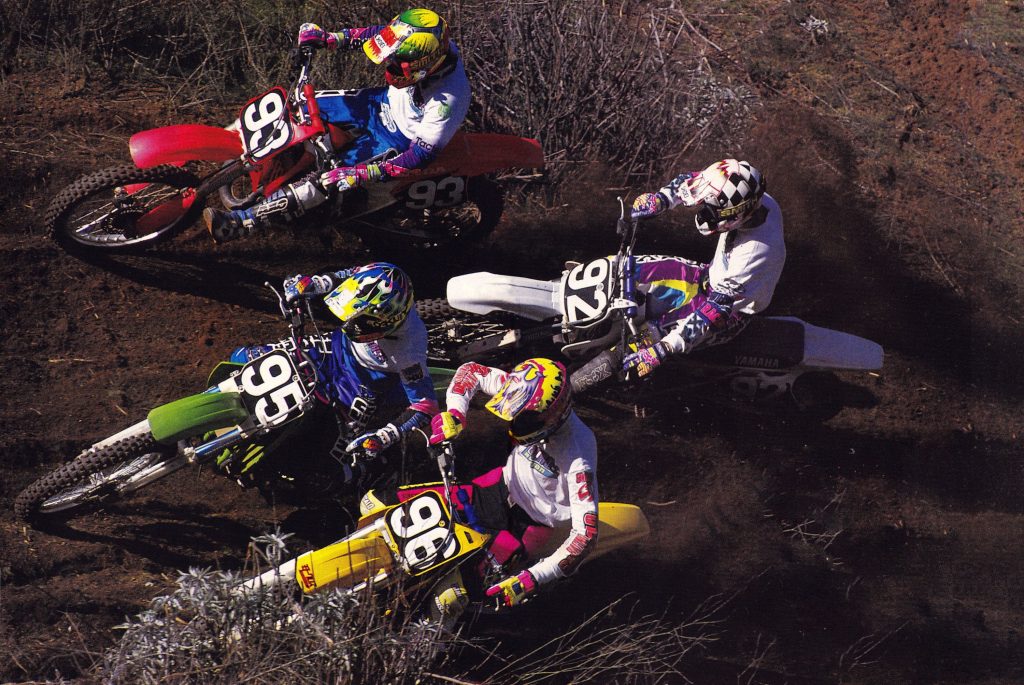 The 1993 125 class featured three legitimate contenders and an underpowered also-ran. While the all-new YZ125 featured one of the best-regarded chassis in the class, its relative lack of power compared to its rivals prevented it from being a legitimate contender without major motor upgrades. Photo Credit: Motocross Action
The 1993 125 class featured three legitimate contenders and an underpowered also-ran. While the all-new YZ125 featured one of the best-regarded chassis in the class, its relative lack of power compared to its rivals prevented it from being a legitimate contender without major motor upgrades. Photo Credit: Motocross Action
On the track, the new RM turned out to be far less different than its radical new look would have predicted. The motor changes for 1993 yielded a more potent but less user-friendly powerband than 1992. There was slightly more power on top and a more potent midrange but less of the low-end torque riders had come to expect from the RM. It took more skill out of corners to get the RM into the meat of its powerband but once it was on the pipe the new motor was faster overall. It offered the strongest midrange hit in the class but there was not a lot of power above or below this explosive blast. It was a dead center powerband that went right NOW and signed off quickly. On tight tracks with short jump approaches the RM’s power was ideal as it leapt out of corners and pulled the RM over tricky doubles with ease. On faster and longer tracks though, its lack of top-end power became a hinderance. If you gave the Honda time to spool up, then it would walk away from the RM. As in previous years, the RM continued to offer a feather-light clutch pull and a very slick-shifting transmission so keeping it in the meat of its narrow power spread was less of a chore than on the similarly punchy but more recalcitrant-shifting Yamaha.
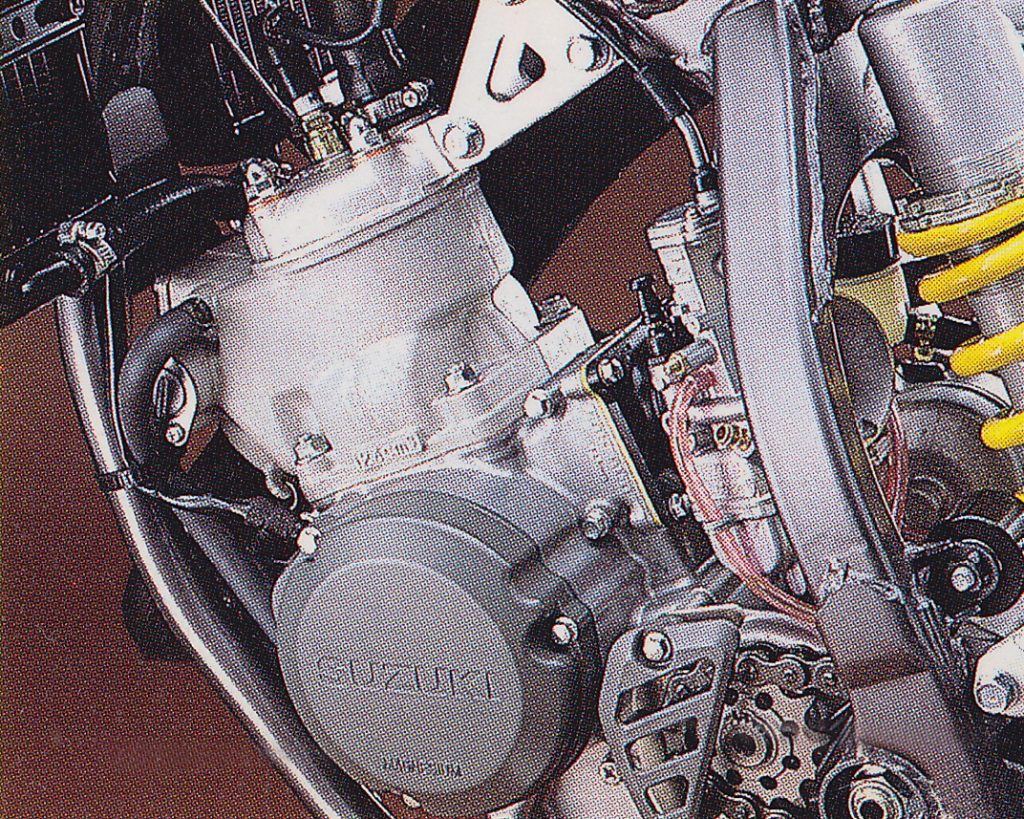 The motor changes for 1993 yielded a more potent burst in the midrange but less torque off idle than 1992. Top end power was improved slightly as well but the RM continued to do its best work over a narrow spread dead center in the power curve. Photo Credit: Suzuki
The motor changes for 1993 yielded a more potent burst in the midrange but less torque off idle than 1992. Top end power was improved slightly as well but the RM continued to do its best work over a narrow spread dead center in the power curve. Photo Credit: Suzuki
On the handling front the RM125 remained one of the sharpest-turning machines in the class. The new ergonomics made it easier to slide forward and the thick midsection gave the rider something to hang on to. It shredded through tight turns and made quick work of tricky switchbacks. The aggressive geometry, light weight, and instant power of the RM made it a dream on Supercross-style circuits. Where things got a little less rosy was outdoors. There, the high speeds and sharp, choppy bumps gave the RM’s chassis a bit of a fit. Out of turns the RM’s front end was very light and prone to headshake. This was the exact opposite of the CR125R which tended to shake its head under braking. This looseness under acceleration was much worse if the track was choppy and the RM could become quite a handful out of rough and fast corners. At speed, the bike never quite felt planted and required constant attention to keep on its intended path. For many 125 pilots this was a fair trade to achieve the RM’s fantastic cornering but there were better bikes available if playing in the desert was on your agenda.
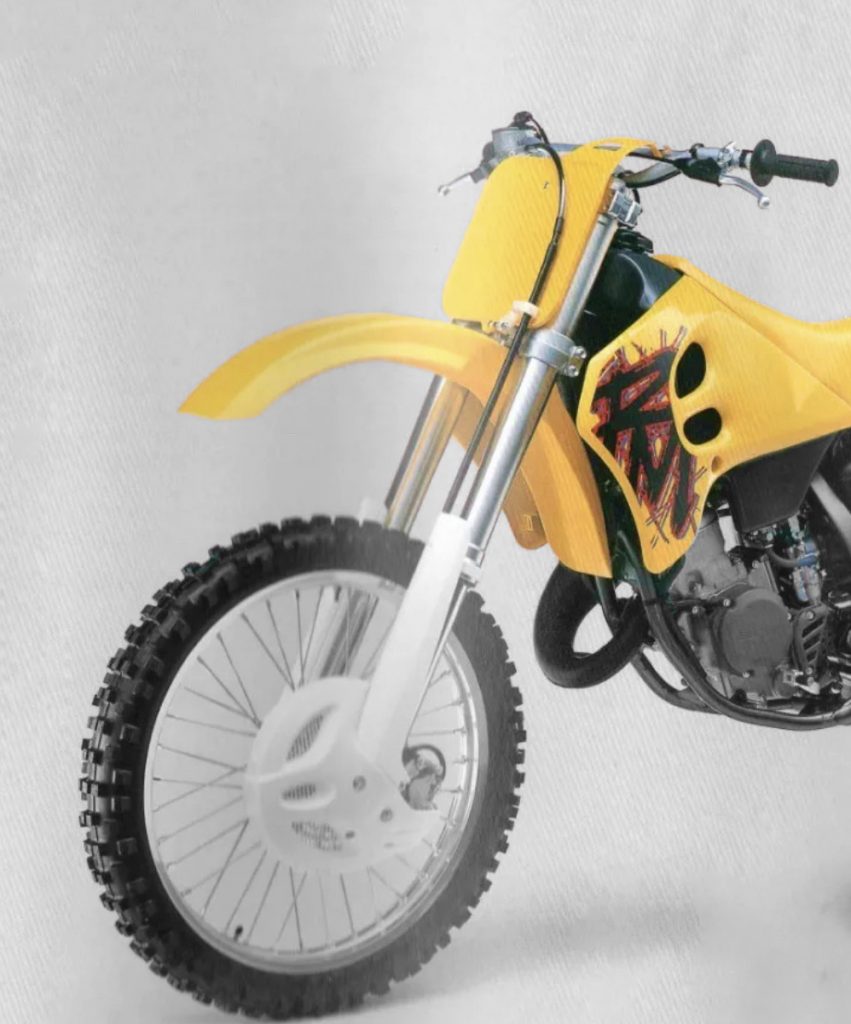 New 45mm Showa forks for 1993 featured revised valving and thinner outer tubes to save weight and improve front end feel. On-track performance was commendable on hard hits but less successful on small chatter and braking bumps. Photo Credit Suzuki
New 45mm Showa forks for 1993 featured revised valving and thinner outer tubes to save weight and improve front end feel. On-track performance was commendable on hard hits but less successful on small chatter and braking bumps. Photo Credit Suzuki
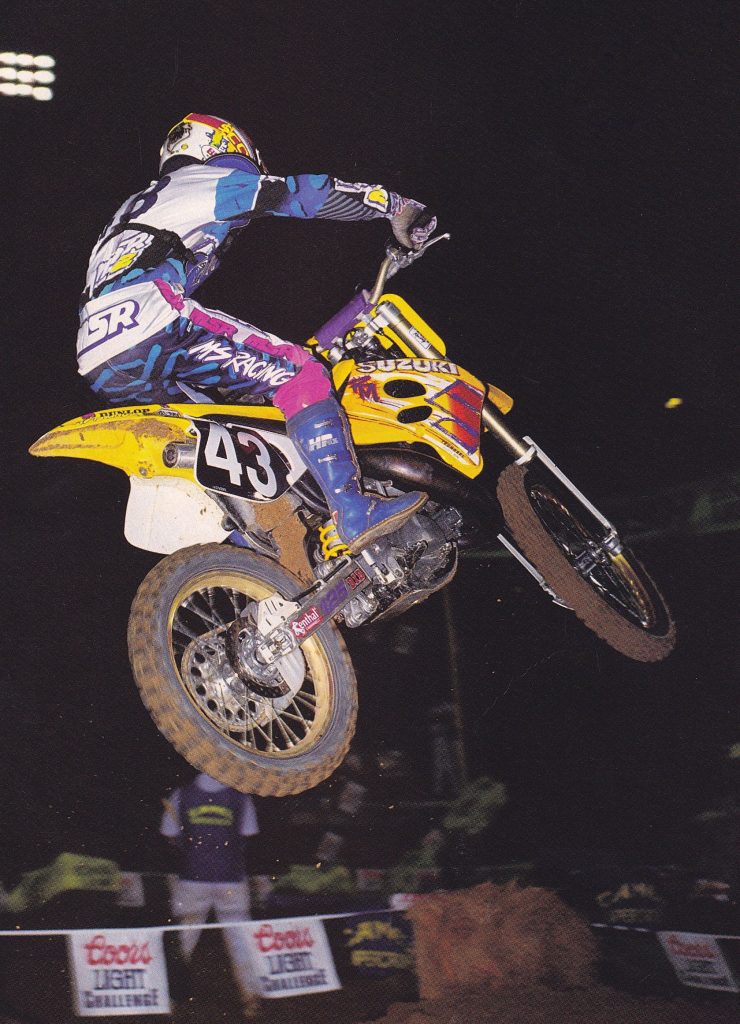 Ezra Lusk took the all-new RM125 to 3rd place in the 1993 125 East Supercross championship. Photo Credit: Ken Faught
Ezra Lusk took the all-new RM125 to 3rd place in the 1993 125 East Supercross championship. Photo Credit: Ken Faught
Some of the RM’s instability out of turns was probably due to the action of its new Showa rear damper. For 85 percent of what a shock is asked to do it worked very well but the small holes and sharp curbs that develop out of turns on a motocross track seemed to flummox its damping somewhat. Jumps, whoops, and G-outs were no issue, but the shock had a hard time dealing with small choppy bumps. This upset the chassis out of rough turns and exacerbated the RM’s inherent instability. Thankfully, this was not a fatal flaw and most riders still rated the RM’s shock as the second best in the field behind Kawasaki’s ultra-plush KX125.
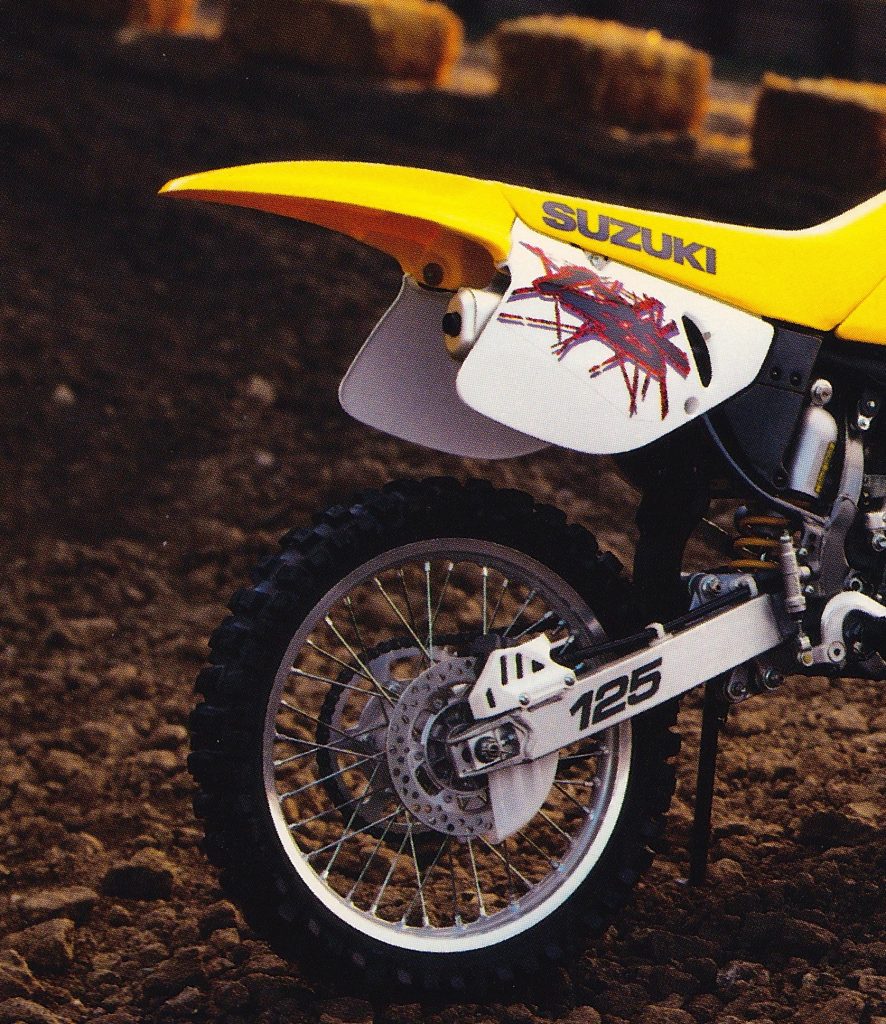 Like the forks, the RM’s new shock was far better at big hits than small chop in 1993. Holes and sharp curbs were transmitted directly to the rider’s backside but big jumps and large whoops were no issue for the stiffly-tuned damper. Photo Credit: Suzuki
Like the forks, the RM’s new shock was far better at big hits than small chop in 1993. Holes and sharp curbs were transmitted directly to the rider’s backside but big jumps and large whoops were no issue for the stiffly-tuned damper. Photo Credit: Suzuki
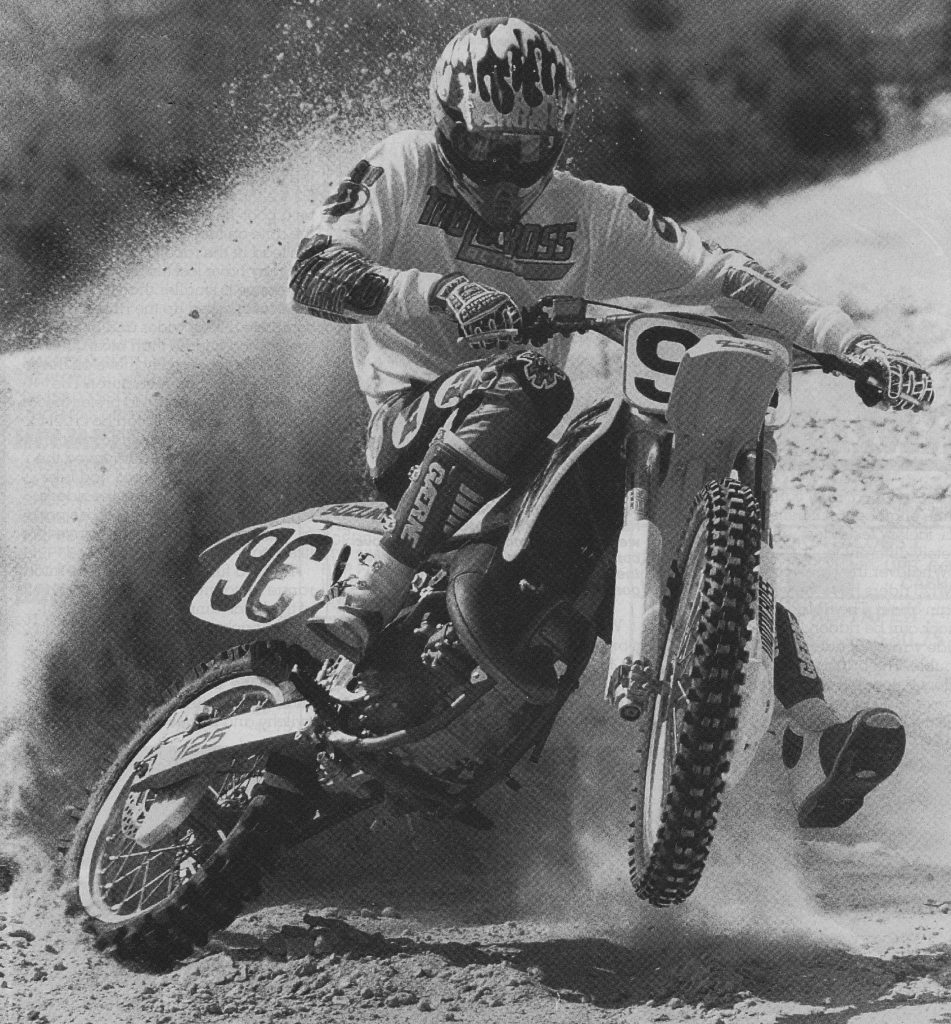 Major midrange power launched the RM out of corners in 1993. No longer the easiest-to-ride machine in the class, the new-look RM offered a snappy and abrupt powerband that catered to experts more than in the past. Photo Credit: Suzuki
Major midrange power launched the RM out of corners in 1993. No longer the easiest-to-ride machine in the class, the new-look RM offered a snappy and abrupt powerband that catered to experts more than in the past. Photo Credit: Suzuki
Up front, the RM125’s new 45mm Showa forks offered adjustments for both compression and rebound damping and 12.2 inches of travel. Like the shock, they worked well on Supercross-style obstacles but tended to be harsh on small chop and square-edged bumps. Big jumps and deep whoops were no issue, but the RM lacked the plushness of the Yamaha and Kawasaki’s front ends once the track got rough. It was still better than the new 43mm Showa forks employed on the CR but most riders preferred the ’92 RM’s fork performance.
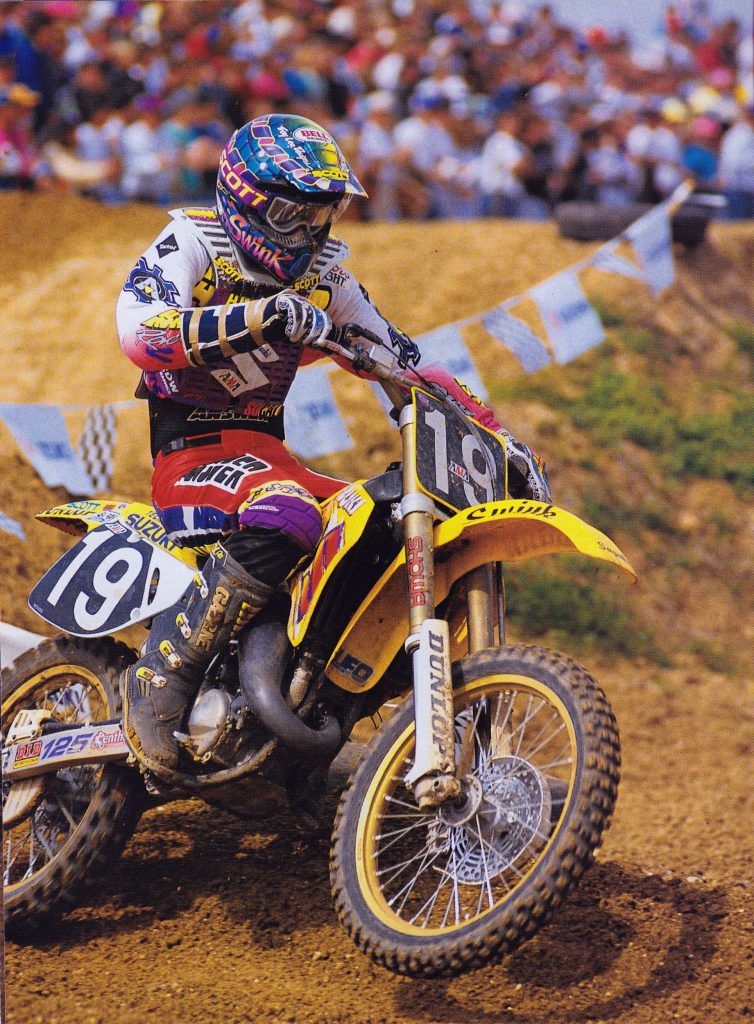 After a lackluster 10th place in the 1992 outdoor standings, Factory Suzuki’s Brian Swink piloted the all-new RM125 to a much-improved 5th overall in 1993. Photo Credit: Dirt Bike
After a lackluster 10th place in the 1992 outdoor standings, Factory Suzuki’s Brian Swink piloted the all-new RM125 to a much-improved 5th overall in 1993. Photo Credit: Dirt Bike
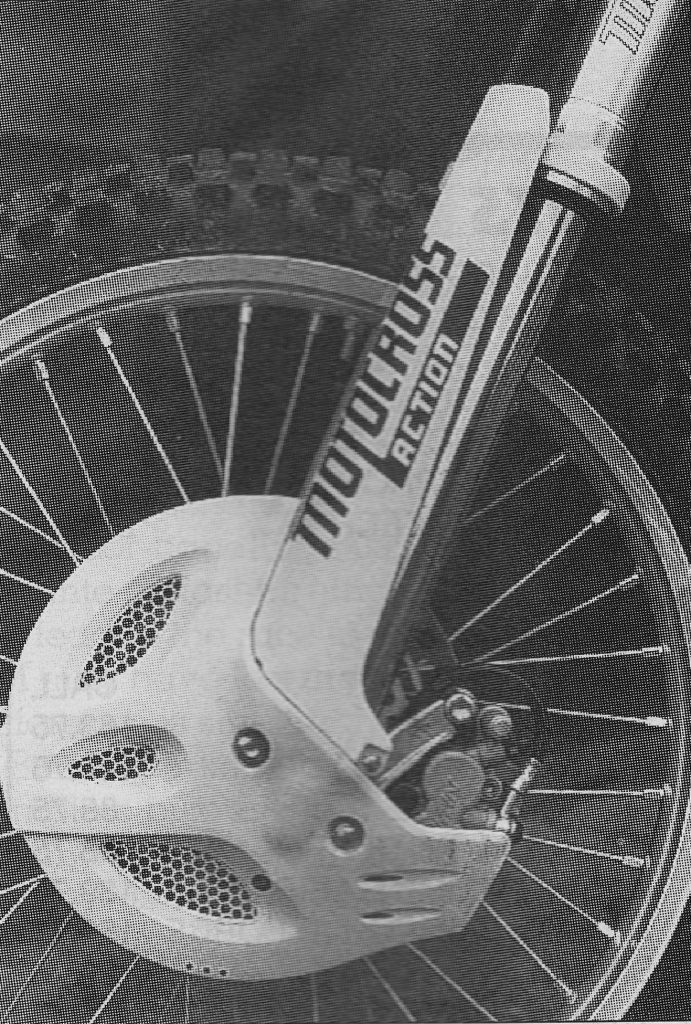 New metallic pads and beefed-up calipers gave the RM125 some of the best brakes on the track in 1993. Photo Credit: Motocross Action
New metallic pads and beefed-up calipers gave the RM125 some of the best brakes on the track in 1993. Photo Credit: Motocross Action
On the detailing front the RM125 was a step behind the best machines in the class at the time. Overall reliability was good but the RM did tend to wear out faster than some of its competition. Piston and ring life was fairly short and air leaks were a common RM issue. The clutch was also not particularly durable and prone to going away if pushed. The quality of the stock bars, chain, seat cover and silencer packing were notoriously poor as well and best replaced with aftermarket alternatives. In addition to being prone to tearing the cover, the front seat mount also liked to pop out of its channel where the seat pan met the tank. On the plus side were the RM’s excellent brakes (second only to the CR), new bodywork (chubby, but good looking and well-shaped), understated graphics (way classier than 1992), and snappy power (super fun).
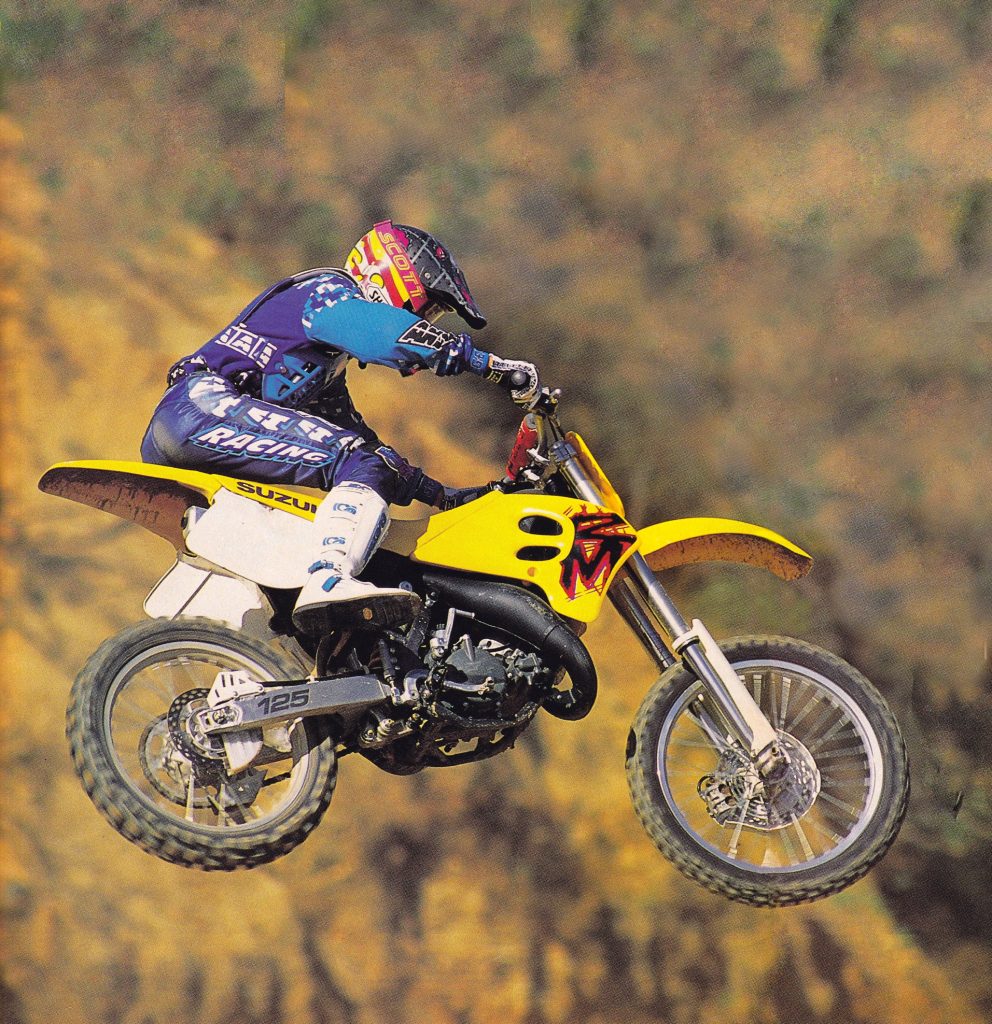 Light, airy, and flickable, the new RM125 was one of the best jumpers in the 1993 125 class. Photo Credit: Dirt Rider
Light, airy, and flickable, the new RM125 was one of the best jumpers in the 1993 125 class. Photo Credit: Dirt Rider
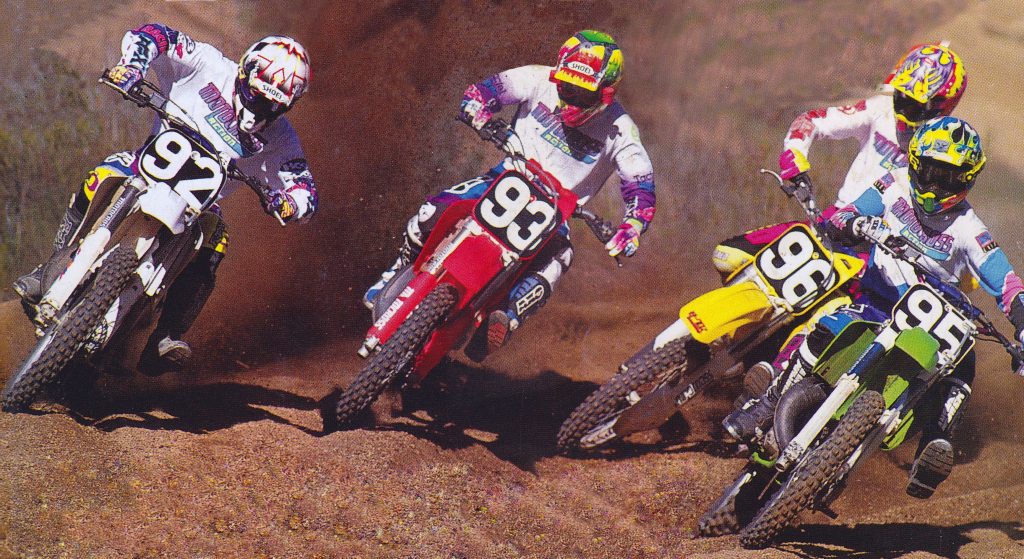 In 1993, the best all-around machine in the 125 class was Kawasaki’s KX125. Its broad powerband and supple suspension made going fast easy. At the other extreme was Honda’s pro-focused CR125, which demanded skill to make the most of its harsh suspension and high-strung motor. In between these two standouts was the RM125 with its hard-hitting midrange motor and lithe handling. All three could win in the right hands but aside from some disconcerting reliability issues, the Kawasaki covered all the bases the best in 1993. Photo Credit: Motocross Action.
In 1993, the best all-around machine in the 125 class was Kawasaki’s KX125. Its broad powerband and supple suspension made going fast easy. At the other extreme was Honda’s pro-focused CR125, which demanded skill to make the most of its harsh suspension and high-strung motor. In between these two standouts was the RM125 with its hard-hitting midrange motor and lithe handling. All three could win in the right hands but aside from some disconcerting reliability issues, the Kawasaki covered all the bases the best in 1993. Photo Credit: Motocross Action.
In the end, the 1993 Suzuki RM125 turned out to be step forward in ergonomics and aesthetics but a step backward in ease-of-use on the track. The motor changes yielded more power in the middle but sacrificed some of the excellent torque riders had enjoyed in 1992. This made the bike more appealing to experts but harder to ride for those of lesser talent. The suspension changes for 1993 also offered mixed results with the RM failing to capture the do-it-all effectiveness of the Kawasaki. It still easily outpaced the fast but harsh Honda’s suspension, but most riders felt the 1992’s suspension package was superior. If you were fast and talented, the 1993 RM125’s overall package was probably a step forward, but for many riders the Kawasaki’s broader power and far better suspension made it a more attractive choice. Not as outright fast as the CR or as incredibly plush as the KX, the 1993 RM125 straddled the middle with sharp turning, a feathery feel, and a snappy power. In 1993, that was not enough to capture the title of the best 125 in the land but the RM125 remained a very competitive machine in the most competitive class in motocross.
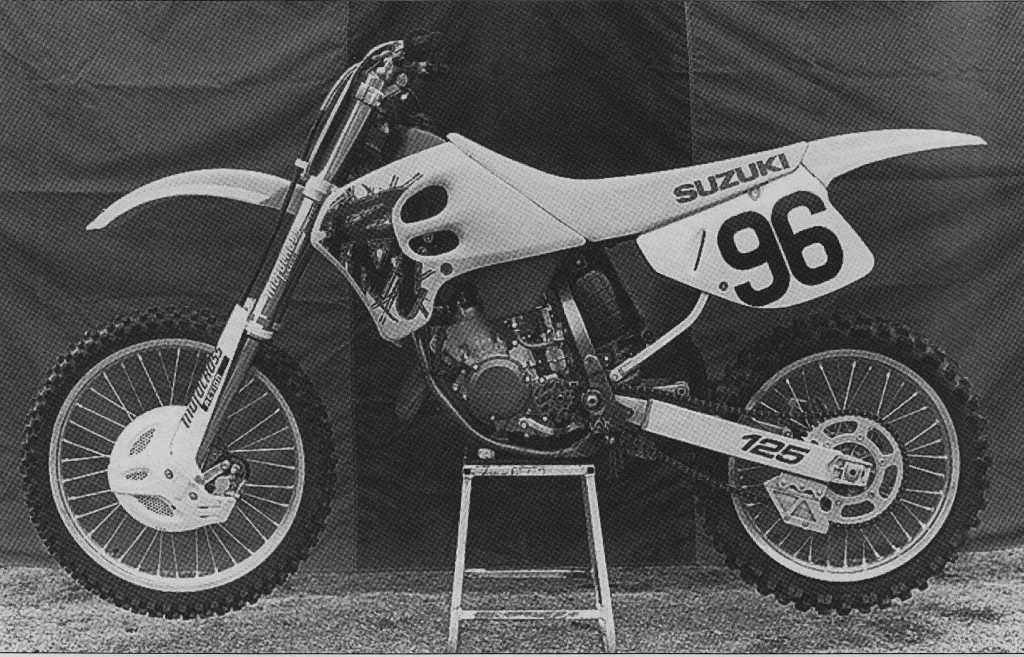 Sexy, sleek, and serious, the Suzuki RM125 offered skilled riders all the tools to make it to the front in 1993. Photo Credit: Motocross Action.
Sexy, sleek, and serious, the Suzuki RM125 offered skilled riders all the tools to make it to the front in 1993. Photo Credit: Motocross Action.
For your daily dose of old school moto goodness, make sure to follow me on Instagram and Twitter @tonyblazier
For questions or comments, feel free to drop me a line anytime at TheMotocrossVault@Gmail.com



